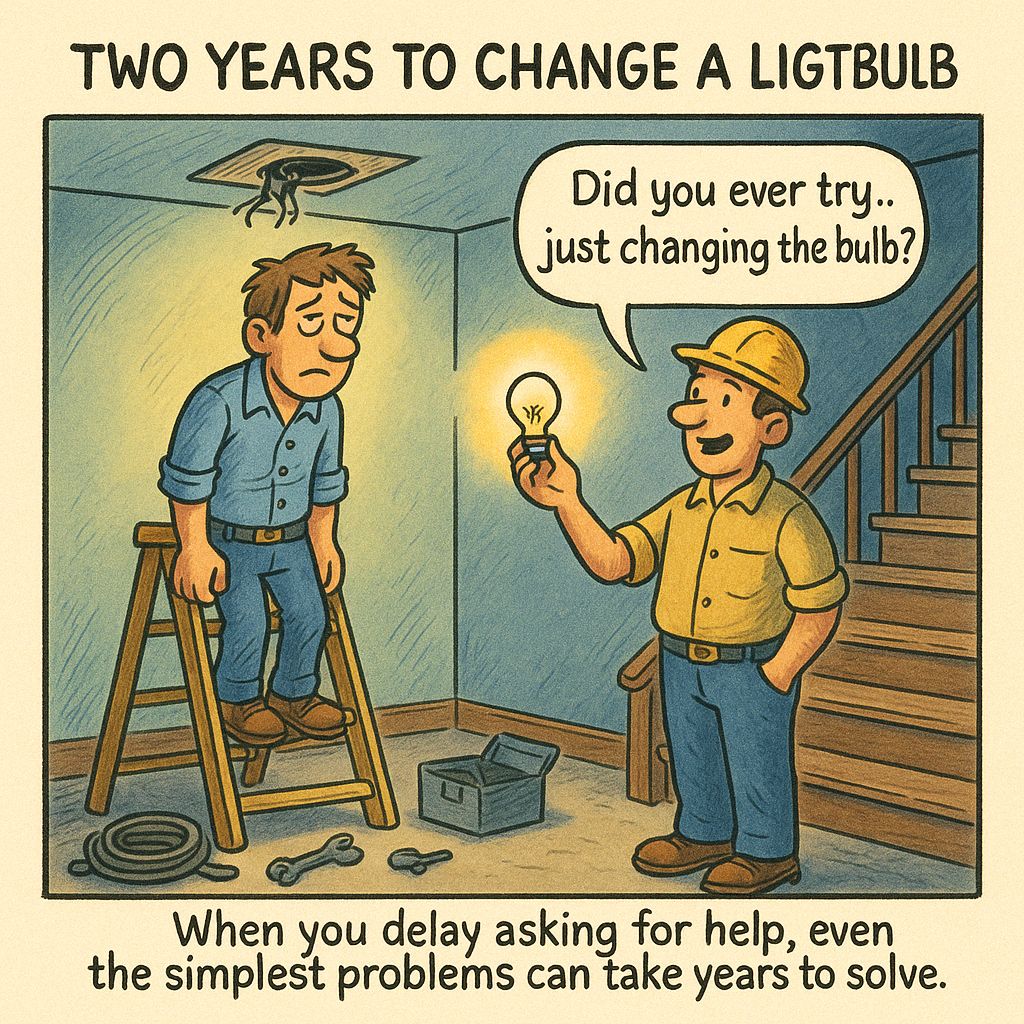Sometimes, a simple task turns into an unexpected saga, and along the way, it teaches us something bigger. This is a true story about a lightbulb that took two years to fix. Yes, two years. And while it might sound like the setup for a bad joke, the story offers surprisingly relevant lessons for anyone navigating a business transformation.

A Real (and Slightly Ridiculous) Delay
In a newly purchased home with the usual long list of renovations, one recurring problem kept getting bumped down the list: a flickering light on the main staircase. The light would turn on and off at random, leaving the stairs in semi-darkness, just inconvenient enough to ignore, but just risky enough to eventually become a concern.
The issue dragged on for months, even as other, more visibly broken things around the house were being addressed. When it finally came time to deal with it, especially before selling the home, the assumption was that something must be wrong with the wiring or the fixture. After taking it apart, testing everything, and putting it back together with no improvement, a professional was finally called in.
Through a process that included FaceTime, a few rounds of troubleshooting, and a lot of head scratching, the culprit was eventually found: a hairline crack at the base of the bulb. That’s right. The issue that took two years to solve could have been fixed in five minutes with a new bulb, if only someone had looked there first.
The Business Transformation Connection
This story might sound ridiculous (because it is), but the pattern is all too familiar in business transformation: small issues go unaddressed, the real fix is simpler than it seems, and the hesitation to ask for help ends up causing more delay and risk than the problem itself.
Here are three common fears that keep organizations from engaging the help they actually need:
1. Reluctance to Engage Professionals for “Small” Jobs
Much like that flickering light, small issues in an organization are often ignored because they seem too minor to justify external help. But these seemingly small issues can quietly introduce risk, stall momentum, and lead to much bigger problems down the line.
2. Fear of Price Gouging and Escalated Costs
There’s always a worry that once a professional is involved, the scope will grow and so will the bill. The lightbulb scenario mirrors this, there was concern that calling in help would turn into a major project. Ironically, delaying the fix made things more complicated (and more frustrating) than they ever needed to be.
3. Concerns About Context and Misunderstanding
Sometimes there’s a fear that outside help won’t understand the context, your systems, your goals, your people. But good experts know how to listen, ask the right questions, and zoom in on what really matters. In this case, it took an outside set of eyes (and a well-timed suggestion) to spot what had been overlooked all along.
What Business Transformation Teams Really Need
If there's a lesson here, it's that delaying expert input, whether out of pride, fear, or the assumption that "we should be able to figure this out" rarely works in your favor. Here’s what actually helps:
Accessible Guidance
Having a trusted expert you can call when something feels off, even if it seems minor, can be a game changer. It’s not about bringing in a full team for every problem. Sometimes all you need is one good conversation.
Avoiding Lengthy, Unfocused Engagements
Nobody wants to sign up for a never-ending consulting contract that’s all diagnosis and no action. Effective support should be focused, short-term, and aimed at delivering immediate value, just like swapping out a lightbulb (once you know that’s the issue).
Timely Support
The longer you wait, the more tangled things can get. Quick access to the right expertise at the right moment can prevent a small issue from escalating into something disruptive, or dangerous.
Wrapping It Up
The lightbulb story is a little absurd. But that’s kind of the point. It’s a real example of how easy it is to avoid fixing something small, only to find out it was a bigger risk than anyone realized. Business transformations often suffer from the same dynamic: delays, assumptions, and hesitations that add up to serious friction.
So if there’s a “lightbulb” flickering somewhere in your organization, something that keeps getting ignored, don’t wait two years to fix it. Find the right person, ask the right questions, and get the right kind of help. It might be simpler than you think.